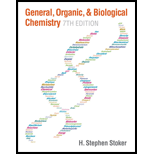
(a)
Interpretation:
The structure of predominant organic product that is formed in the given reaction has to be drawn.
Concept Introduction:
Alcohols undergo halogenation reaction to give halogenated product. Alcohols on halogenation gives halogenated product in which the hydroxyl group present in the alcohol is substituted by the halogen. Phosphorous trihalides are useful in producing

(b)
Interpretation:
The structure of predominant organic product that is formed in the given reaction has to be drawn.
Concept Introduction:
Dehydration reaction is the loss of water from a single reactant. Alcohol undergoes dehydration reaction to form
(c)
Interpretation:
The structure of predominant organic product that is formed in the given reaction has to be drawn.
Concept Introduction:
In
In organic chemistry, reduction reaction is referred to the number
Alcohols do undergo
(d)
Interpretation:
The structure of predominant organic product that is formed in the given reaction has to be drawn.
Concept Introduction:
Dehydration reaction is the loss of water from a single reactant. Alcohol undergoes dehydration reaction to form alkene. Sulfuric acid acts as a catalyst for hydration of alkene at room temperature. The same sulfuric acid acts as a dehydrating agent when treated with alcohol at high temperature. If the reaction is carried out at a lower temperature, the loss of water molecule takes place from two molecule of reactant. This results in the formation of ether. Primary alcohol when treated with sulfuric acid at lower temperature (
Trending nowThis is a popular solution!

Chapter 14 Solutions
GENERAL,ORGANIC,+BIO.CHEM.-MINDTAP
- Please draw the major product(s) of the following reaction and show the mechanism. Is there a reason why one stereochemistry is preferred over the other for this reaction?arrow_forwardSelect the aldol condensation product of the following reaction. a A b B с C d D e E A H HO H NaOH, EtOH heat H H B D Earrow_forwardDraw the major organic product obtained from the following sequence of reactions (assume that mixtures of ortho and para disubstituted compounds can be separated; continue the synthesis with either one)? (Draw your major product and upload the drawing using the submission link.) CH3 HNO3 H₂SO4 K2Cr2O7 H₂SO4 H2, Ni NaNO2, H3O+ KIarrow_forward
- Draw the major organic product obtained form the following sequence of reactions (assume that mixtures of ortho and para disubstituted compounds can be separated; continue the synthesis with either one)? NO₂ Br, FeBr3 H2, Ni NaNO2, H3O+ HBF4arrow_forwardDraw the major organic product of the following reaction: 1. (CH3CH2)2NH, H+ (cat.) 2. о H 3. H3O+arrow_forwardWhat is the product of the following reaction?arrow_forward
- b) The above molecule may be further converted into a polymer with similar molecular structure to that of polyester. Describe the conditions of this process and write down the reaction for each step.arrow_forwardWhat is the major organic product obtained from the following reaction? CH3 2 4 3 1 (CH3)2C=CH2 HF CH3 CH3 CH3 1 2 3arrow_forwardIt is sometimes necessary to prepare isotopically labeled samples of organic substances for probing biological transformations and reaction mechanisms. Various sources of the radioactive mass-14 carbon isotope are available. Describe synthetic procedures by which benzoic acid, labeled with 14C at its carbonyl carbon, could be prepared from benzene and the following 14C-labeled precursors. You may use any necessary organic or inorganic reagents.(a) CH3Cl (b) CO2arrow_forward
- What is the carbohydrate classification for the product produced when each of the following undergoes complete hydrolysis?arrow_forwardDraw the product AND propose a reasonable, detailed stepwise mechanism, using curved arrow notation to show the flow of electrons, for the following reaction.arrow_forwardConsider the intermolecular forces present in a pure sample of each of the following compounds: CH₃CH₂OH and CH₃COCH₃. Identify the intermolecular forces that these compounds have in common.arrow_forward
 Human Anatomy & Physiology (11th Edition)BiologyISBN:9780134580999Author:Elaine N. Marieb, Katja N. HoehnPublisher:PEARSON
Human Anatomy & Physiology (11th Edition)BiologyISBN:9780134580999Author:Elaine N. Marieb, Katja N. HoehnPublisher:PEARSON Biology 2eBiologyISBN:9781947172517Author:Matthew Douglas, Jung Choi, Mary Ann ClarkPublisher:OpenStax
Biology 2eBiologyISBN:9781947172517Author:Matthew Douglas, Jung Choi, Mary Ann ClarkPublisher:OpenStax Anatomy & PhysiologyBiologyISBN:9781259398629Author:McKinley, Michael P., O'loughlin, Valerie Dean, Bidle, Theresa StouterPublisher:Mcgraw Hill Education,
Anatomy & PhysiologyBiologyISBN:9781259398629Author:McKinley, Michael P., O'loughlin, Valerie Dean, Bidle, Theresa StouterPublisher:Mcgraw Hill Education, Molecular Biology of the Cell (Sixth Edition)BiologyISBN:9780815344322Author:Bruce Alberts, Alexander D. Johnson, Julian Lewis, David Morgan, Martin Raff, Keith Roberts, Peter WalterPublisher:W. W. Norton & Company
Molecular Biology of the Cell (Sixth Edition)BiologyISBN:9780815344322Author:Bruce Alberts, Alexander D. Johnson, Julian Lewis, David Morgan, Martin Raff, Keith Roberts, Peter WalterPublisher:W. W. Norton & Company Laboratory Manual For Human Anatomy & PhysiologyBiologyISBN:9781260159363Author:Martin, Terry R., Prentice-craver, CynthiaPublisher:McGraw-Hill Publishing Co.
Laboratory Manual For Human Anatomy & PhysiologyBiologyISBN:9781260159363Author:Martin, Terry R., Prentice-craver, CynthiaPublisher:McGraw-Hill Publishing Co. Inquiry Into Life (16th Edition)BiologyISBN:9781260231700Author:Sylvia S. Mader, Michael WindelspechtPublisher:McGraw Hill Education
Inquiry Into Life (16th Edition)BiologyISBN:9781260231700Author:Sylvia S. Mader, Michael WindelspechtPublisher:McGraw Hill Education





